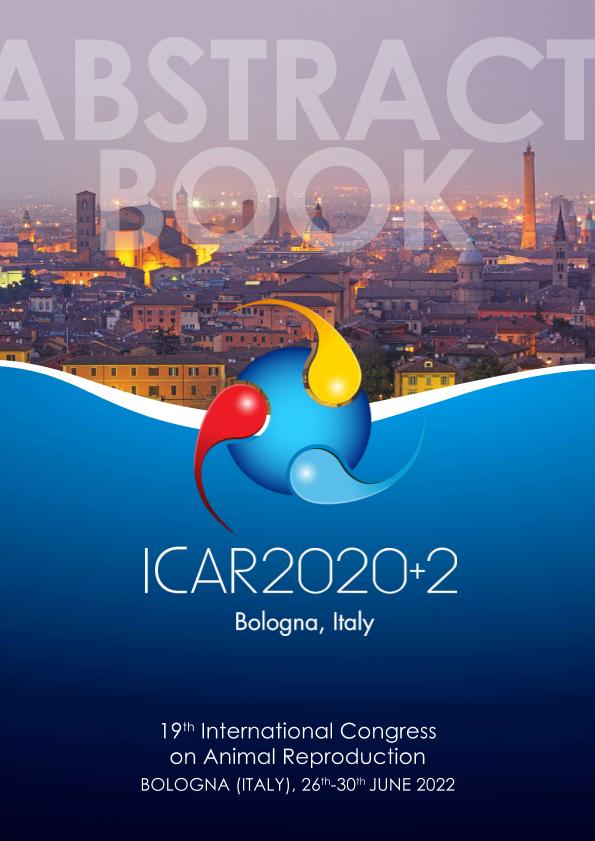Mostrar el registro sencillo del ítem
dc.contributor.author
Rossetto, Liliana
dc.contributor.author
Gallelli, Maria Florencia

dc.contributor.author
Bianchi, Carolina Paula

dc.contributor.author
Franco, Gabriel
dc.contributor.author
Miragaya, Marcelo

dc.date.available
2024-01-30T15:53:05Z
dc.date.issued
2022
dc.identifier.citation
Effect of 1000 IU of synthetic eCG like glycoprotein on follicular development and embryo recovery in llamas; 19th International Congress on Animal Reproduction; Bologna; Italia; 2022; 173-173
dc.identifier.uri
http://hdl.handle.net/11336/225273
dc.description.abstract
The aim of this study was to evaluate the effect of asynthetic eCG like glycoprotein on follicular development and embryo production, as an alternative to native eCGin llamas. METHODS: Twenty non-gestating and non-lactating llamas wereexamined daily by transrectal ultrasonography (tUS) to assesovarian status (MyLab One Vet, ESAOTE) until a growingfollicle with a diameter ≥7 mm, considered ovulatory in thisspecies, was observed. At that moment, females received8 μg of a GnRH analog (IV) (buserelin acetate, Gonaxal®Biogénesis Bagó, Argentina) (Day 0). On Day 3, tUS wasperformed to confirm the absence of follicles > 5 mm andthen animals were divided in two groups: eCG-N (n= 10)received 1000 IU of native eCG (IM) (Novormon®, Syntex,Argentina), and eCG-R (n= 10) received 1000 IU of asynthetic eCG like glycoprotein (IM) (Syntex, Argentina).On Day 7, all llamas were injected with 112.5 μg ofcloprostenol (IM) (Enzaprost®, Biogénesis Bagó). On Day10, the number of ovulatory follicles were determined bytUS and then llamas were mated with a male with provenfertility. Afterwards, females were injected with 8 μg ofbuserelin acetate (IV) and 24 h later, natural mating was repeated with another male, in order to minimize the male effect. On Day 18, the number of corpus luteum (CL) that developed after mating were assessed by tUS and then embryo recovery was performed by uterine flushing. The number of follicles that developed after treatment andthe number of collected embryos between groups werecompared by Mann-Whitney test. The number of CL that developed after mating between groups were comparedby unpaired t-test. Values are expressed as mean ± SEM.RESULTS: No significant differences were observed between groupsin the number of ovulatory follicles observed on Day 10(10.5±2.9 vs. 8.4±1.3 in the eCG-N and eCG-R, respectively), nor in the number of CL that developed after mating(9.2±3 vs. 8.2±1.2 in the eCG-N and eCG-R, respectively).The number of collected embryos did not show significant differences between groups (2.6±1.1 and 3.3±1.1 in theeCG-N and eCG-R, respectively). CONCLUSIONS: The synthetic eCG like glycoprotein shows a similar effect with regards to follicular development and embryo collection than the native eCG.
dc.format
application/pdf
dc.language.iso
eng
dc.publisher
Universidad de Bologna
dc.rights
info:eu-repo/semantics/openAccess
dc.rights.uri
https://creativecommons.org/licenses/by-nc-sa/2.5/ar/
dc.subject
eCG
dc.subject
LLAMA
dc.subject
EMBRYO TRANSFER
dc.subject
SUPERSTIMULATION
dc.subject.classification
Ciencias Veterinarias

dc.subject.classification
Ciencias Veterinarias

dc.subject.classification
CIENCIAS AGRÍCOLAS

dc.title
Effect of 1000 IU of synthetic eCG like glycoprotein on follicular development and embryo recovery in llamas
dc.type
info:eu-repo/semantics/publishedVersion
dc.type
info:eu-repo/semantics/conferenceObject
dc.type
info:ar-repo/semantics/documento de conferencia
dc.date.updated
2023-12-28T14:46:48Z
dc.journal.pagination
173-173
dc.journal.pais
Italia

dc.journal.ciudad
Bologna
dc.description.fil
Fil: Rossetto, Liliana. Universidad Nacional de La Pampa. Facultad de Ciencias Veterinarias; Argentina
dc.description.fil
Fil: Gallelli, Maria Florencia. Consejo Nacional de Investigaciones Científicas y Técnicas; Argentina. Universidad de Buenos Aires. Facultad de Ciencias Veterinarias. Instituto de Investigación y Tecnología en Reproducción Animal; Argentina
dc.description.fil
Fil: Bianchi, Carolina Paula. Consejo Nacional de Investigaciones Científicas y Técnicas. Centro Científico Tecnológico Conicet - Tandil. Centro de Investigación Veterinaria de Tandil. Universidad Nacional del Centro de la Provincia de Buenos Aires. Centro de Investigación Veterinaria de Tandil. Provincia de Buenos Aires. Gobernación. Comision de Investigaciones Científicas. Centro de Investigación Veterinaria de Tandil; Argentina
dc.description.fil
Fil: Franco, Gabriel. Universidad Nacional de La Pampa. Facultad de Ciencias Veterinarias; Argentina
dc.description.fil
Fil: Miragaya, Marcelo. Universidad de Buenos Aires. Facultad de Ciencias Veterinarias. Instituto de Investigación y Tecnología en Reproducción Animal; Argentina
dc.relation.alternativeid
info:eu-repo/semantics/altIdentifier/url/https://iris.unito.it/retrieve/f08db1bf-68d0-4fa7-896d-80abfe6967f9/ICAR%202020%2B2%20abstract-book%20T81%20pp%20135.pdf
dc.conicet.rol
Autor

dc.conicet.rol
Autor

dc.conicet.rol
Autor

dc.conicet.rol
Autor

dc.conicet.rol
Autor

dc.coverage
Internacional
dc.type.subtype
Congreso
dc.description.nombreEvento
19th International Congress on Animal Reproduction
dc.date.evento
2022-06-26
dc.description.ciudadEvento
Bologna
dc.description.paisEvento
Italia

dc.type.publicacion
Book
dc.description.institucionOrganizadora
Universidad de Bologna
dc.source.libro
Book of abstracts of the 19th International Congress on Animal Reproduction
dc.source.revista
19th International Congress on Animal Reproduction
dc.date.eventoHasta
2022-06-30
dc.type
Congreso
Archivos asociados
